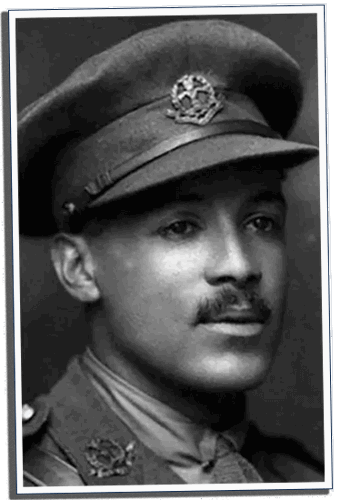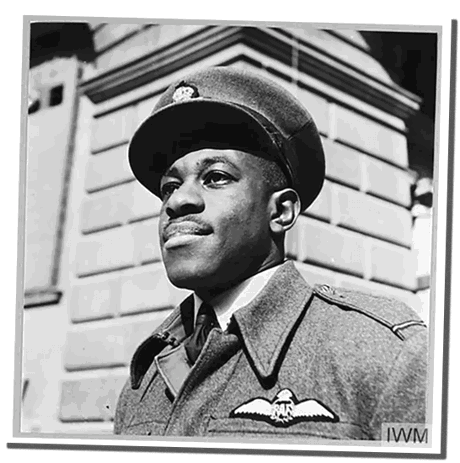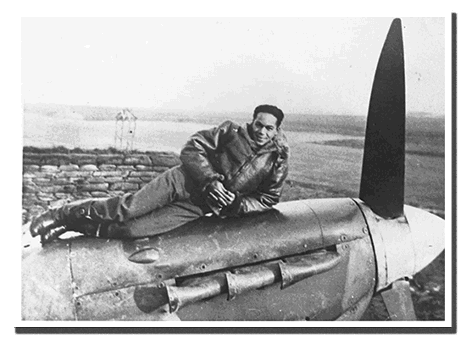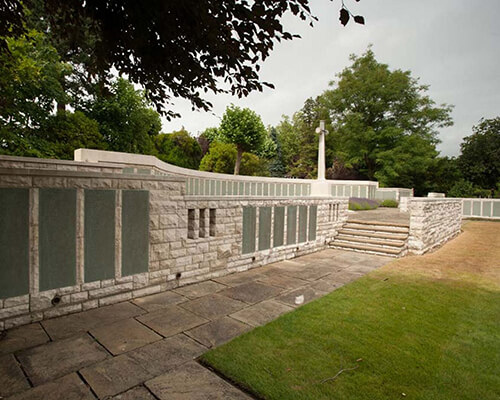
Their Service, Our History: Honouring Black Contributions
Honouring Black men and women whose service shaped Britain’s story.
For generations Black men and women have served with Allied forces, on land, at sea and in the air - serving with skill, discipline and pride. The lives remembered here reflect a far greater story, one of courage, loyalty and service that strengthened Britain and earned a lasting place through history.
Why We Mark Black History Month
Black History Month UK, observed every October, is a vital moment to honour and reflect on Black British history, celebrating the achievements and recognising the sacrifices of Black communities across the nation.
It is a chance to remember the contributions of Black soldiers and service personnel who served during the two World Wars. Their bravery and sacrifice are integral to our national history and the story of the Commonwealth.
By spotlighting their contributions, we can ensure that Black military service is remembered with dignity and their stories are woven into the broader tapestry of remembrance.

Image: IWM (D 24609) EAST AFRICANS IN LONDON: LIBERATED EAST AFRICAN SOLDIERS SEE THE SIGHTS, LONDON, ENGLAND, UK, 1945.
Understanding Black Military Service
Telling the stories of the two world wars is impossible without recognising the contributions of Black British service men and women, as well as other Black servicepeople from across the Commonwealth.
Black History Month UK offers us the chance to put a spotlight on some of these stories and uncover the history of the two world wars.
Historical Context: Black contributions in WW1 and WW2
During both World Wars, Black British service personnel as well as servicemen and women from across the Commonwealth played a vital role in shaping the our military history.
Thousands of men and women from the Caribbean and Africa joined British forces, serving in the British West Indies Regiment, the Royal Air Force, and other units. These Colonial troops in British forces and Commonwealth soldiers in the UK often faced discrimination, yet they stood firm in their commitment to the war effort.
Figures like Walter Tull, Emanuel Thomas and Sydney Cornell have become enduring symbols of Black British war heroes - but represent just some of the stories of Black British soldiers we remember today.
Black History Month UK continues to honour these contributions, highlighting stories that were long overlooked in mainstream narratives. Their legacy is a cornerstone of Britain's diverse wartime heritage.
Beyond the Battlefield: Roles in logistics, medical services, engineering, and support
Throughout both world wars, Black personnel would fulfil vital roles in logistics, engineering and support.
These unglamourous, and often overlooked, contributions to the war effort were of vast importance – without food, fuel and ammunition, no army can fight.
In the First World War alone, more than 200,000 non-combatant porters, stevedores and followers served with the Military Labour Corps, transporting valuable supplies across the east African terrain – which was often impassable for vehicles.
Units like the Labour Corps found themselves deployed to battlefields far from home, carrying out backbreaking labour, often in the face of enemy action.

Image: IWM (SE 224) Askaris of the 11th East African Division at a battle training centre in Ceylon receiving instruction on the 40mm Bofors anti-aircraft gun, 1944.
Commonwealth Connections: Contributions from Kenya, Sierra Leone, and the Caribbean
During the First World War, a large number of volunteers from the West Indies travelled to the UK to volunteer for service and in 1915, the British West Indies Regiment (BWIR) was formed.
Throughout the war, the BWIR raised 10 battalions for service overseas. More than 15,000 BWIR men and around 400 officers would serve in several theatres, including the Western Front, Italy, Egypt and Palestine.
In the Second World War, units of Black soldiers again rose to the challenge.
In the Pacific Theatre, the King’s African Rifles played a key role in the Allies’ eventual victory in the region, while others fought in the air, becoming pilots and aircrew of the RAF.
Black servicemen and women would serve across the globe, including in the merchant navy - playing an important part in keeping the supply lines open despite the immense danger that came with serving at sea.
Personal Stories of Courage and Sacrifice
Our records commemorate 1.7 million Commonwealth men and women who died during the two world wars. We remember their stories and preserve them for the next generation.
Featured Profiles: Sergeant Sidney Cornell, Walter Tull, Emanuel Adeniyi Thomas

Second Lieutenant Walter Tull
Second Lieutenant Walter Tull is perhaps the most well known Black serviceman of the First World War.
Before the war, Walter was a natural sportsman, coming to prominence in England’s amateur football scene before signing a professional contract with Tottenham Hotspur in 1909, transferring to Northampton Town in 1911.
At the outbreak of the First World War, Walter volunteered for the army and joined the Footballers' Battalion of the Middlesex Regiment, and fought in the Battle of the Somme in 1916. He was a natural leader and in May 1917 was commissioned as an officer – a remarkable achievement given the prejudices of the time.
Walter fought with distinction and survived into 1918, but was ultimately killed on 25 March during the German Spring Offensive. His body was never recovered and he is commemorated on the Arras Memorial to the Missing.

Flight Lieutenant Emanuel Adeniyi Thomas
Flight Lieutenant Emanuel Adeniyi Thomas was born in Lagos in 1914. Inspired by the stories of the Battle of Britain, Emanuel sailed to Liverpool in 1942 and volunteered for the RAF.
Emanuel became the first West African to qualify as a pilot, receiving his commission in 1942 and served until his death in 1945.
On 12 January, Emanuel was flying a training mission over the Brecon Beacons in South Wales alongside Wireless Operator Frank Stokes. Bad weather set in, and the pair crashed into a mountainside. Despite Frank walking for two miles to fetch help, Emanuel did not survive and is buried in Haycombe Cemetery in Bath.

Sergeant Sidney Cornell DCM
Sergeant Sidney Cornell DCM was born in Portsmouth to an African American father and a British mother. After signing up for the Second World War, Sidney served first in the Royal Army Service Corps before volunteering to join the Airborne corps.
Sidney would serve with the 7th Parachute Battalion who played a key role in the invasion of Normandy, tasked with capturing key bridges on D-Day and taking part in several operations in France. Sidney earned a reputation for incredible bravery and was awarded the DCM for his actions during the campaign.
Sidney was killed on 7 April during Operation Varsity, when a bridge his battalion were trying to capture was destroyed by German defenders. He is buried in Becklingen War Cemetery in Germany.
For Evermore: Stories of the Fallen
Make sure the stories Black British history are not forgotten by uploading them to our For Evermore stories portal.
We are aiming to collect as many stories as possible of the men and women we commemorate so that they can be remembered in perpetuity.
This Black History Month is the perfect opportunity to research and remember the stories of the Black men and women who paid the ultimate price in service to their country and the Commonwealth.
From Overlooked to Remembered: Our Work in Preserving History
Recovering Forgotten Names: Archival research and record updates
Following the findings of the Special Committee in 2021, a significant portion of work carried out by our programme to address historical inequalities in commemoration after the world wars has included archival research.
One such research project included a new estimate for the number of soldiers and carriers raised from across East Africa who died in British imperial service during the East Africa campaign of the First World War.
By better understanding the numbers of servicemen, we are better equipped to tell the stories of the men and women who served and provide a deeper understanding of this dimension of the war.
A recently released report on commemoration during and after the Second World War continues this work to uncover forgotten names and incomplete records, including civilian war deaths across the British Empire.
Sites of Remembrance Across the UK and Commonwealth
We commemorate Black servicemen in Europe, in our sites around the world and at home in the UK. Discover a few of our sites below, to inspire your next visit to one of our cemeteries and memorials.
Key Memorials in the UK
 On 25 January 1917, the SS Mendi left Cape Town, transporting some 823 men of the South African Native Labour Corps destined for France. For many, this would be a final voyage.
On 25 January 1917, the SS Mendi left Cape Town, transporting some 823 men of the South African Native Labour Corps destined for France. For many, this would be a final voyage.
By 19 February, the Mendi had reached the English Channel. After a brief stop in Plymouth, the Mendi set said for France. As she passed the Isle of Wight, conditions were poor as a thick fog descended.
Emerging from the dark and fog, the SS Darro struck the Mendi amidships. The Mendi was fatally wounded and sank quickly. Almost 650 men her crew and the Labour Corps were lost with her.
The majority of those who died have no known grave and are commemorated by name on the Hollybrook Memorial in Southampton.
 Runnymede Air Forces Memorial bears the names of pilots and aircrew who lost their lives during the Second World War and who have no known grave.
Runnymede Air Forces Memorial bears the names of pilots and aircrew who lost their lives during the Second World War and who have no known grave.
Inscribed on its walls are the names of more than 20,000 casualties, including several Black casualties, such as Flying Officer Hugh Terrence Ettiene, who moved to the UK from St. Lucia, serving as a Flight Engineer with 214 Squadron, Bomber Command.
Hugh’s Stirling Mk3 was shot down while returning from a bomber raid over Essen in Germany, killing the entire crew.
Commonwealth Memorials: Sierra Leone, Kenya, Cape Town
Earlier this year, we were delighted to announce a new memorial honouring the fallen from the Sierra Leone Carrier Corps.
During the First World War, non-combatant labourers and soldiers from across Africa played a crucial role in supporting military campaigns. Among them, the Carrier Corps were essential to the war effort.
These men were recruited to carry supplies and materials across difficult terrain that could not be navigated by vehicles or animals, ensuring that frontline troops received the resources they needed to continue fighting. Many of them died in service and have never been properly commemorated.
The new memorial design is a radical contemporary intervention in which a prism of structural glass rises above the existing memorial designed by Sir Edwin Lutyens in 1930, a modern memorial that recognises the legacy of service in Sierra Leone.
Learn more about our new Sierra Leone Memorial
January 2025 marked an extraordinary moment in our history, as we unveiled our newest memorial to the missing in Cape Town’s Company’s Garden.
This new memorial commemorates by name over 1700 South Africans who served for the military labour corps and died during the First World War. These men were previously unrecognised, with no known grave or commemoration.
Completing this new memorial is a culmination of years of work, starting with the research that led to the identification of these casualties, through to the collaborative design and creation of our new memorial in Cape Town.
Voices of the Past: this Black History Month
Watch the moving interviews from a CWG Foundation-funded project that shines a light on the previously overlooked contributions on Kenyan and East African veterans for served in the Second World War.
Tens of thousands fought in the campaigns across some of the most challenging campaigns of the war, across the continent of Africa and in Burma, southeast Asia. By sharing these stories – again – this October, we provide a new and continued remembrance.
Listen to the Voices of Veterans
Black History Month: Education resources
In cemeteries and memorials across the world, you can discover the stories of those from the Black community who served in both World Wars. Our resource is designed to provide you with a selection of ideas as to how schools can incorporate the stories of Black service personnel and their contributions to the war effort into their work around Black History Month.

